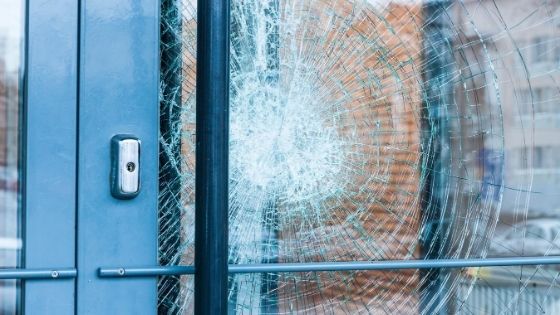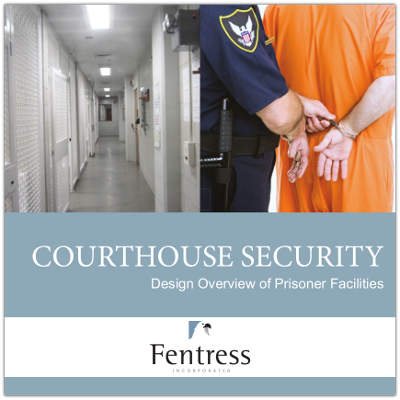by Keith Fentress (Fentress Inc.) and Mike Jones (President, Major Security Consulting and Design, LLC)
The courthouse is an iconic civic building representing the ideals of justice. Typically one of the more prominent government facilities in a community, the courthouse is often the location of choice for peaceful protests. Many such protests are associated with the outcome of cases. However, during times of civil unrest, protesters often lash out at the courthouse because it is an institution of government and represents justice...or the lack thereof.
Courthouse security is focused on keeping the public and occupants safe within the courthouse and in managing the movement of prisoners. Law enforcement personnel who provide courthouse security rarely have the staff required to both defend the facility AND protect its occupants. Additionally, they often do not have the specialty equipment and training necessary to defend the building and grounds/parking areas. During recent violent protests, courthouses have been damaged by protesters throwing debris, breaking glass, setting fires, and targeting security guards. It is our belief that security standards for courthouses should be broadened to help protect the courthouse from violent protests.
Traditionally, exterior courthouse security has focused on the building setback, vehicle barriers, clear sightlines, the hardening of walls and windows, and secure parking for judges. Many of these security features have come about since the 1995 Oklahoma City bombing and the wave of recent active shooter events. As such, they are focused on protecting the building from bomb blasts and gun fire. Security guidelines now need to consider civil unrest and protecting the courthouse against an angry violent protest from potentially hundreds of people.
This article provides recommendations that are largely based on the principles of Crime Prevention through Environmental Design (CPTED – 1st and 2nd Generations), which is a method used to evaluate the design of the built environment based upon an analysis of security and safety threats, vulnerabilities, and risks. The recommendations are no- or low-cost options that can be implemented for existing courthouses. In a future blog, we will present ideas for improving court security for new construction.
Remove Debris
People who participate in protests typically do not bring rocks or other heavy objects from home to throw at security personnel or the courthouse. If a protest turns violent, the protesters find objects in the surrounding environment to throw. For that reason, security and building maintenance personnel should walk the courthouse site and surrounding areas to remove rocks, chunks of asphalt, glass bottles, and other heavy objects that can do damage when thrown. This should be part of the daily security routine for each court facility.
Consideration should be given to rock or gravel used in landscaping. While great for aesthetics and preventing weeds, landscaping rocks and gravel should be removed. Gravel used in plant beds can be replaced by a nonflammable mulch to keep up the aesthetic appeal while removing objects that can be thrown.
Also, remove any trash cans from the exterior of the courthouse as they can be thrown or used to start fires.
Trim Landscaping
Properly trim landscaping with bushes and plants trimmed to a height of no more than 3 feet and branches on trees limbed up to ten feet or higher. Maintaining the landscaping can provide unobstructed sightlines for security personnel to see people approaching the courthouse. Also, trimmed landscaping prevents people from hiding out of view of cameras or security personnel.
Vehicle Barriers
Many courthouses have security standards that require setbacks from the street and bollards or similar vehicle barriers protecting the courthouse. If such standards are not in place, barriers or planters can be installed to prevent vehicle intrusion.
Fences
Courthouses are welcoming to the public and typically do not have fences on the property. However, temporary anti-climb fences can be erected during periods of civil unrest to help protect the courthouse. The fence height would need to be at least 8 feet for adequate protection. It should be noted that fences are not foolproof. Violent protesters can and will topple a fence. However, fences can act as an initial deterrent that can prevent many protesters from getting close to the courthouse by defining protected and prohibited areas.
A longer-term solution would be to install security fencing around the courthouse property. We have only seen such fences at a handful of court locations. However, reasonably attractive anti-climb and vehicle crash-rated fencing can be permanently installed, which will help keep a buffer between violent protesters and the courthouse. Such fences are a permanent solution for a problem that can arise in an instant.
Even if using fencing to secure the entire property is not a realistic consideration for a courthouse, it can be used in a more limited fashion for “target-specific” protection to safeguard gas lines, HVAC intakes, emergency generators, and other critical mechanical elements that are at ground level.
Security Cameras
Cameras on the exterior of the courthouse can greatly aid security personnel in monitoring the courthouse grounds. Ideally, cameras should be installed so that there are no blind spots around the perimeter of the courthouse. Internet protocol (IP) cameras usually have high resolution and allow security personnel to zoom in on potential risks. All cameras should have at least pan-tilt-zoom (PTZ) capability and vandal-resistant housing, and should be mounted at a height that prevents obstruction or tampering. For a more advanced camera option, consider artificial intelligence/analytic CCTV, which can enhance courthouse security capabilities.
Lighting
Since many violent protests extend into the night, adequate lighting should be installed around the courthouse so that security personnel can monitor protesters. Lighting provides clearer views, allows for the identification of offenders and threat situations, and illuminates potential hiding places. Since courthouse sites and conditions vary greatly, there is no one answer for lighting levels. A security or lighting specialist should be consulted to evaluate the conditions and to recommend the best lighting for a particular courthouse.
Exterior Hardening
It’s important that the exterior of the courthouse be hardened against thrown debris and potential fire that could occur during a violent protest. A primary concern is the volume of glass typically used in courthouse lobby construction. While providing ample daylight and clear sightlines, breaking glass can become dangerous during a violent protest (especially from blasts) and can potentially allow protesters to gain access to the courthouse. Ensure that glass and windows are hardened with glaze or impact-resistant film. Such hardening will help prevent the glass from breaking when hit with rocks and bottles.
Hardening should also be considered for non-glass areas. Many courthouses are constructed out of sturdy and durable materials, while others are typical office building construction with an exterior that can be more easily damaged. As additional protection, some courthouses have added concrete, reinforced columns, fire-retardant coatings, etc. However, there are so many varying conditions and risks that require a security specialist to be consulted.
Court Security is not Aimed at Peaceful Protests
While courthouses must be protected from violent protesters who attempt to damage property or harm courthouse occupants, none of these features should be considered to deter peaceful protests in any way. All Americans have the freedom to protest in a peaceful fashion.
Security for violent protest should focus on deterrence and not force, which should only be used as a last resort. The recommendations above are not meant to be a definitive list but rather a start to the dialogue of how to protect courthouses and promote the administration of justice. The time to discuss the changing risk to courts is NOW as the level of threat is increasing. We welcome your views and contributions.
______________________________________________________________________________
Click on the image below to download the Courthouse Security Guide.






.jpg)
.jpg)
.jpg)
.jpg)
.jpg)
.jpg)
.jpg)
-1.jpg)
.jpg)
.jpg)
.jpg)
.jpg)
.jpg)

